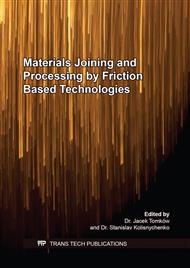[1]
W. M. Thomas, E. D. Nicholas, J. C. Needham, M. G. Murch,P. Temple-Smith and C. J. Dawes: Friction stir butt welding,, GB patent no. 91259788, (1991).
Google Scholar
[2]
C.D. Marioara, S.J. Andersen, J. Jansen, H.W. Zandbergen. The influence of temperature and storage time at RT on nucleation of the β'' phase in a 6082 Al–Mg–Si alloy. Acta Materialia 51 (2003) 789–796.
DOI: 10.1016/s1359-6454(02)00470-6
Google Scholar
[3]
Wang Gang, Yin Zhimin, Zhao Kai, Duan Jiaqi, Liu Bo, Shang Baochuan. TTT curve of 6082 aluminium alloy and its research. Materials Science and Technology, August 2011, No. 19, No. 4.
Google Scholar
[4]
Jae-Hyung Chon, Won Jae Kim, Chang Gil Lee. Texture and microstructure evolution and mechanical properties during friction stir welding of extruded aluminum billets. Materials Science & Engineering A 597(2014)314-323.
DOI: 10.1016/j.msea.2013.12.087
Google Scholar
[5]
Ma Zhiyun, Feng Haifeng, Chen Delong, Shen Jie. Recent advances in friction stir welding/processing of aluminium alloys: microstructural evolution and mechanical properties. Solid and Materials Science Review, 2017, Vol. 0, No. 0, PP. 1-65.
DOI: 10.1080/10408436.2017.1358145
Google Scholar
[6]
Magdy M. El-Rayes, Ehab A. El-Danaf. The influence of multi-pass friction stir processing on the microstructural and mechanical properties of Aluminum Alloy 6082. Journal of Materials Processing Technology 212 (2012) 1157–1168.
DOI: 10.1016/j.jmatprotec.2011.12.017
Google Scholar
[7]
A.H. FENG, D.L. CHEN, and Z.Y. MA Microstructure and Low-Cycle Fatigue of a Friction-Stir-Welded 6061 Aluminum Alloy. The Minerals, Metals & Materials Society and ASM International (2010).
DOI: 10.1007/s11661-010-0279-2
Google Scholar
[8]
Long Wan, Yongxian Huang, Zongliang Lv, Shixiong Lv, Jicai Feng. Effect of self-support friction stir welding on microstructure and microhardness of 6082-T6 aluminum alloy joint. Materials and Design 55 (2014) 197–203.
DOI: 10.1016/j.matdes.2013.09.073
Google Scholar
[9]
Effects of tool sizes and welding parameters of F.C. Liu and Z.Y.Ma. on the structure and mechanical properties of friction stir welding of 6061-T651 aluminum alloy. Metallurgical and Materials Trading Volume A.2378-39A, October (2008).
DOI: 10.1007/s11661-008-9586-2
Google Scholar
[10]
M. Dehghani , A. Amadeh, S.A.A. Akbari Mousavi Investigations on the effects of friction stir welding parameters on intermetallic and defect formation in joining aluminum alloy to mild steel. Materia ls and Design49(2013)433-441.
DOI: 10.1016/j.matdes.2013.01.013
Google Scholar
[11]
U.F.H.R. Suhuddin, S. Mironov ∗ , Y.S. Sato, H. Kokawa Grain structure and texture evolution during friction stir welding of thin 6016 aluminum alloy sheets. Materials Science and Engineering A 527 (2010) 1962–(1969).
DOI: 10.1016/j.msea.2009.11.029
Google Scholar
[12]
S. J. Andersen, H. W. Zandbergen, J. Jansen, C. Træhol ,U. Tundal and O. Reiso. The crystal structure of the β''phase in Al-Mg-Si alloy. Acta mater. Vol. 46, No. 9, p.3283–3298, (1998).
DOI: 10.1016/s1359-6454(97)00493-x
Google Scholar
[13]
S.J. Andersen, C.D. Marioara, A. Frøseth, R. Vissers, H.W. Zandbergen. Crystal structure of the orthorhombic U2-Al 4 Mg 4 Si 4 precipitate in the Al–Mg–Si alloy system and its relation to theβ'andβ, phases. Materials Science and Engineering A 390 (2005) 127–138.
DOI: 10.1016/j.msea.2004.09.019
Google Scholar
[14]
Ø. Frigaard, Ø. Grong, and O.T. Midling. A process model for friction stir welding of age hardening aluminum alloys. Metallurgical and Materials Transactions A. volume 32a, may 2001—1189.
DOI: 10.1007/s11661-001-0128-4
Google Scholar
[15]
Minoru Furukawa, Yoshinori Iwahashi, Zenji Horita, Minoru Nemoto, Nikolai K. Tsenev, Ruslan Z. Valiev Andterence G. Langdon. Structural evolution and the hall-petch relationship in an Al-Mg-Li-Zr alloy with ultra-fine grain size. Acta mater. Vol. 45, No. 11, p.47514757, (1997).
DOI: 10.1016/s1359-6454(97)00120-1
Google Scholar
[16]
Yutaka S. Sato, Mitsunori Urata, Hiroyuki Kokawa, Keisuke Ikeda. Hall-Petch relationship in friction stir welds of equal channel angular-pressed aluminium alloys. Materials Science and Engineering A354 (2003) 298-305.
DOI: 10.1016/s0921-5093(03)00008-x
Google Scholar



